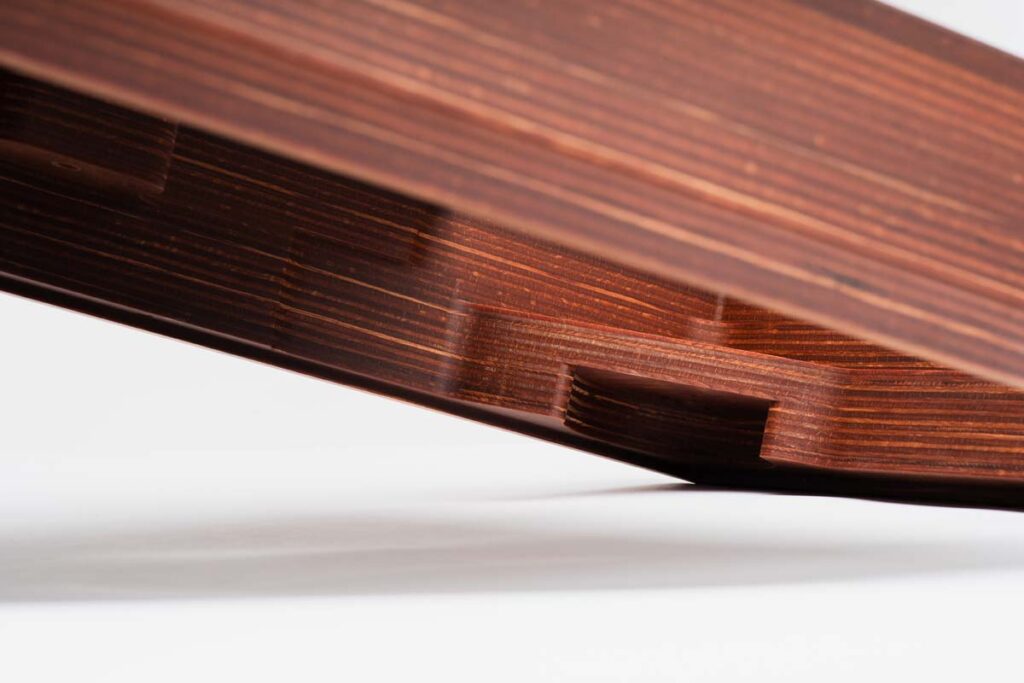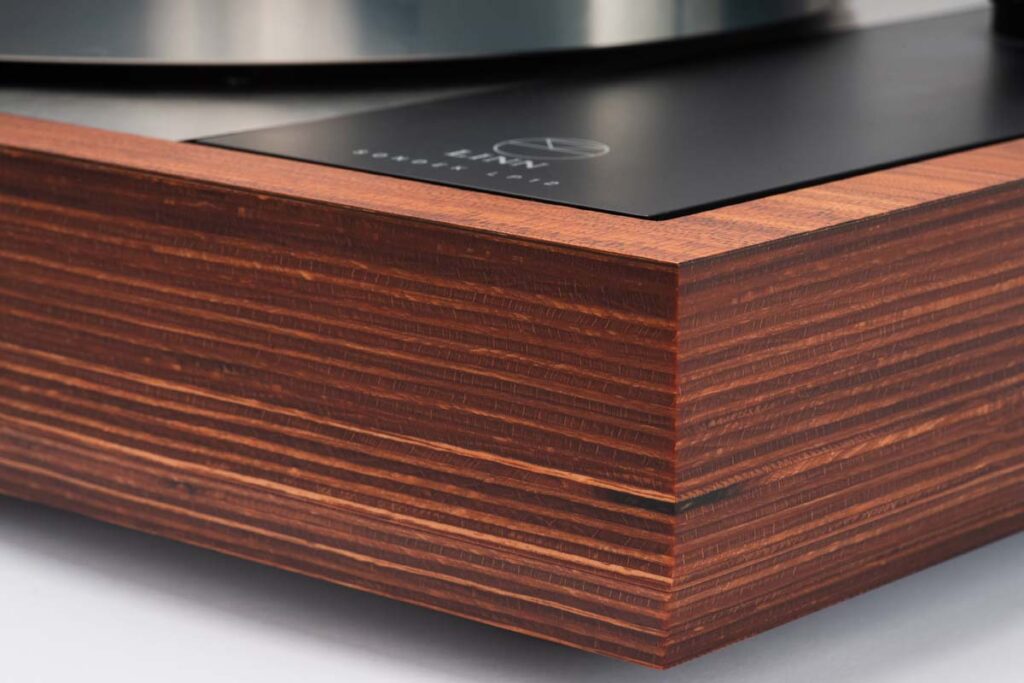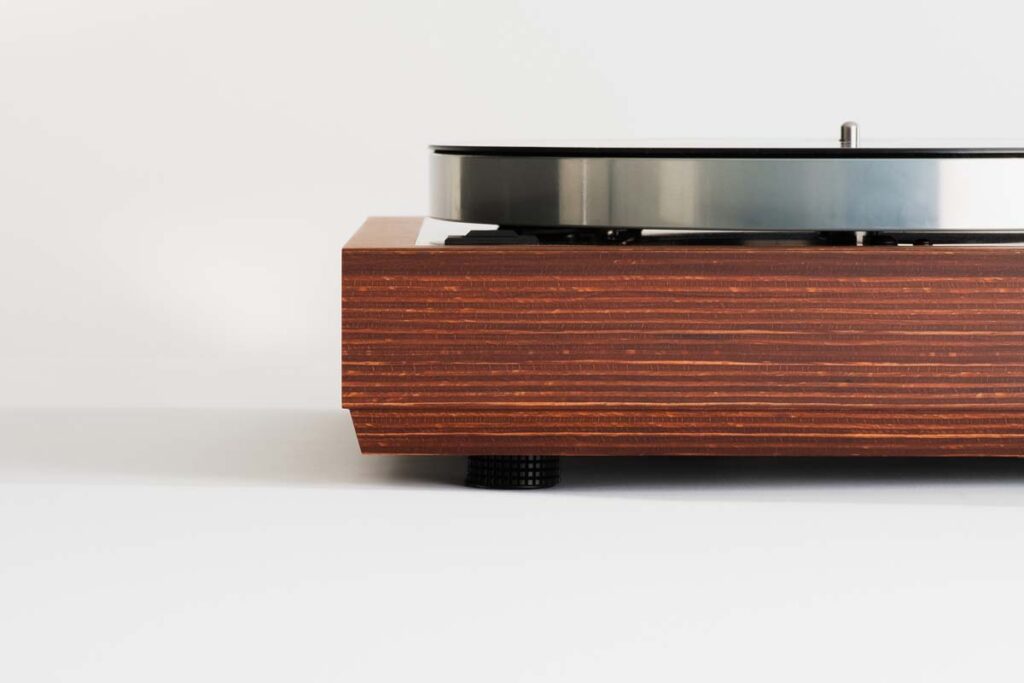If you missed out on the strictly limited Linn Sondek LP12-50 special edition (only 250 units) – or simply found it too expensive – you can still enjoy one of its most impressive innovations: the Bedrok plinth, which is now available as a standalone option.
And you don’t need to buy a brand-new LP12 in full Klimax trim to experience the sonic benefits of the Bedrok. Of course, this pleasure still doesn’t come cheap: the plinth alone costs nearly as much as two entry-level LP12s in the Majik configuration. Patience is also required – for now, Bedrok units are trickling out to dealers in very small quantities. Since a proper comparison between the standard and the new chassis requires two identical LP12s equipped to the same specification, it’s understandable that dealers are reluctant to pull such setups from their demo systems and lend them out for weeks at a time.
For that reason, our editor-in-chief and I traveled to Franconia and spent a highly enjoyable and enlightening day at HiFi Studio Nürnberg. Managing director Stefan Stumbeck and his team accomplished the seemingly impossible: they prepared two identical, fully equipped LP12 Klimax turntables – one with and one without the Bedrok plinth – especially for our visit. Interestingly, the demonstration system didn’t even use Linn’s top-tier playback chain; the setup consisted of a Selekt DSM and the brand-new Majik 150 loudspeakers. This could be seen as a confirmation of Linn’s long-held philosophy: if you want to improve the performance of your entire system, always start at the source.
When you look at the evolution of the Linn Sondek LP12 over the decades (see timeline below), one thing stands out: nearly every mechanical component has become either more robust or manufactured to tighter tolerances, minimizing susceptibility to unwanted resonances. That makes perfect sense when you consider the micro-world in which a tiny diamond stylus must extract minute signals from equally tiny grooves on a record. Mechanical precision is absolutely paramount if record playback is to happen as cleanly as possible. Advances in materials science and machining over the past decades have enabled levels of accuracy that were unimaginable in the early 1970s. Linn’s engineers have continuously incorporated these improvements into the LP12, which explains the sheer number of upgrades released over the years. These refinements have transformed the LP12 from a high-quality but typical 1970s subchassis turntable into a modern reference that has held its own against quartz-locked direct drives and massive high-end designs.
A particularly striking example of Linn’s engineering philosophy came in 2006 with the introduction of the Keel subchassis. Whereas the earlier design consisted of several parts (subchassis, cross brace, armboard, and arm collar), the Keel – machined from a single block of aluminum – unified them into one solid piece. Linn identified the adhesives and screws required in the previous design as potential sources of resonance and eliminated them. The result: the tonearm and cartridge now operate under far better conditions, producing a more precise and controlled sound. The same principle clearly guided the development of the Bedrok plinth.
In the standard (already very sturdy) wooden plinth, additional wood elements are required to reinforce the corners or support the steel base plate. In the Bedrok, such reinforcements are unnecessary – they are integral to the form itself, which is CNC-milled from a solid block of resin-bonded beechwood composite. The milling process also creates all the necessary cutouts, stiffeners, and supports to hold the top plate and make room for the subchassis, wiring, motor, and control electronics.
The Bedrok is made from cross-laminated beech veneers that are compressed under high pressure and heat with synthetic resin. According to Linn, the resulting material is roughly twice as dense as a conventional plinth and practically resonance-free. Unlike standard plinths, which can be ordered in various real-wood finishes or painted in any color, the Bedrok is available only in a medium-brown tone, with the layered veneer structure clearly visible. It exudes a refined elegance and a sense of flawless craftsmanship. It’s also nice to see that Linn has finally added captive nuts for the base plate, dust cover hinges, and other internal fittings – making assembly easier and ensuring long-term stability.
As convincing as the Bedrok’s engineering concept sounds, it ultimately has to prove itself to the ear. And it does – unmistakably! From the very first notes of The Royal Ballet – Gala Performances (Reference Recordings), the differences and similarities between the two fully Klimax-equipped LP12 versions became apparent. Both – as well as the simpler Majik and Selekt variants – retain that distinctive Linn character. It’s an elusive quality: perhaps a combination of musical flow and rhythmic drive that compels you to focus entirely on the music. The LP12 has always had this quality. Even a vintage late-1970s LP12 I recently heard with an SME 3009 Improved tonearm displayed that magic.
The modern versions – and especially a fully upgraded LP12, with or without Bedrok – are far more precise yet remain faithful to their musical roots. With the Bedrok, however, the music seems to play just a touch more quietly, while the acoustic space – in which the Royal Opera House Orchestra under Ernest Ansermet performs so brilliantly – feels larger.
The difference is even easier to hear on I Remember by Dianne Reeves, particularly in “The Nearness of You/Misty.” The jazz singer and the bass accompanying her at the beginning of the song are more clearly separated, and the soundstage opens up toward the rear. The Bedrok also lets the bass strings decay more naturally. When I play the same track on my slightly aging LP12 at home, it sounds almost as if the singer and bassist were recorded in mono.
To confirm my impressions, I challenged the audience – including Indira Bornkessel, Linn’s top representative for Germany, who attended the event – with something far from “easy listening”: the film score from the Japanese anime Akira. The spectacular imagery of the film is matched by an equally dramatic soundtrack by Tsutomu Ohashi, performed with his amateur ensemble Geinoh Yamashirogumi – a fusion of traditional and modern musical elements. It’s not only unusual to Western ears but also a true test for any playback system.
The piece I chose, “Tetsuo,” portrays one of the film’s main characters undergoing a grotesque mutation. Musically, it’s a wild ride – one that, of course, doesn’t faze a standard LP12. Yet with the Bedrok plinth, the various percussion instruments, kondo drums, pipe organ, and choir are more cleanly separated and rendered with greater transparency. The Bedrok-equipped LP12 simply maintains better control and paints the tonal colors of the instruments with finer brushstrokes.
Overall, the Bedrok increases contrast within the musical presentation, making it easier to follow individual melodies or soloists. Despite its ambitious price tag, the Bedrok plinth can be wholeheartedly recommended to Linn Sondek LP12 enthusiasts who wish to follow the Scottish path to perfection all the way. The sonic gains – and the resulting listening pleasure – are undeniable. The Bedrok plinth is a long-lasting, value-retaining investment in a music-filled future.
HIGHLIGHTS FROM LINN’S UPGRADE HISTORY
- 1972: Introduction of the Linn Sondek LP12
- 1974: Main bearing bushing revised; subchassis reinforced with spot-welded band
- 1981: Nirvana (various mechanical components)
- 1982: Valhalla quartz-controlled motor power supply (33 rpm)
- 1984: Larger corner braces in plinth
- 1984: Subchassis brace now epoxy-bonded instead of spot-welded
- 1985: Corner reinforcement blocks added to plinth
- 1990: Lingo I (optional quartz-controlled PSU for synchronous motor, 33/45 rpm)
- 1991: Heavier aluminum baseplate replaces fiberboard (Trampolin optional)
- 1992: Improved top plate mounting
- 1993: Cirkus upgrade (larger inner platter, new bearing, new springs, armrest, belt)
- 2006: Keel subchassis with integrated armboard, milled from solid aluminum (optional)
- 2006: Aluminum baseplate standard; Trampolin II optional
- 2008: Majik power supply for AC synchronous motor (33 rpm)
- 2009: Radikal DC motor and power supply (optional)
- 2013: Kore subchassis with aluminum armboard (optional)
- 2018: Lingo IV quartz-controlled DC motor PSU (33/45 rpm, optional)
- 2020: Introduction of Karousel main bearing
- 2022: Limited LP12-50 (250 units) with Bedrok plinth, full Klimax spec, rounded design elements for 50th anniversary
- 2025: Bedrok plinth introduced as an upgrade option for all LP12 models
Accompanying Equipment
Turntable: Linn Sondek LP12 (Radikal (Klimax), Keel) | Tonearm: Linn Ekos SE/1 | Cartridge: Linn Ekstatik | Phono preamp: Urika II | Network player: Selekt DSM (3x Power Output, 3x Organik DAC) | Speakers: Linn Majik 150 (active)
Turntable Plinth Linn Bedrok
Concept: Special plinth for the Linn Sondek LP12 | Features: Milled from a single block of high-density beech composite | Warranty: 5 years | Price: approx. €12,060 (around €10,410 as an upgrade for an existing LP12)
Linn Products Ltd.
Bedrok™ is a registered trademark of Linn Products Limited, whose name is derived from the English term “bedrock.” It refers to a solid layer of rock in the lowest crust of the earth, on which later layers of earth were deposited.









